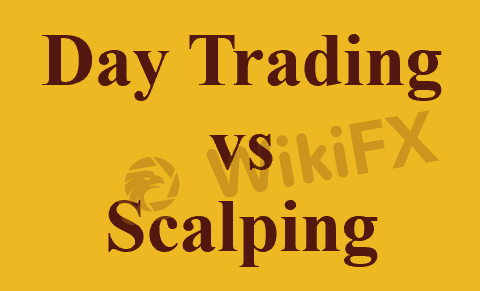Welcome to the Forex Encyclopedia Channel of WikiFX, a professional knowledge-sharing platform. Here, we'll compare and contrast the two trading styles of “forex day trading” and “forex scalping,” as well as examine their trading strategies and offer some guidance on how to decide between the two. We hope you can learn more about two trading strategies and thus make a wise decision in your forex trading.
A Brief Introduction of Day Trading & Scalping

Day trading and scalping are two common short-term trading strategies used in forex trading. Traders that engage in day trading and scalping are also among the most common types of traders on the foreign exchange market.
Forex Day Tradingis a trading strategy that involves opening and closing trades during the same trading day. Forex day traders capitalize on the tiny price fluctuations that occur during the day or session. This sort of trading can be conducted on any market, however it is most commonly employed on the currency, stock, and index markets due to their great liquidity.
Forex Scalpingis a trading strategy that involves placing trades with short durations ranging from a few seconds to several minutes. Scalpers may execute dozens or even hundreds of trades in a single trading session by quickly entering and quitting the market in order to profit from slight price fluctuations.
Here is an intuitive look of forex day trading and forex scalping :

Similarities & Differences of Day Trading and Scalping
Forex scalping does not involve overnight trade holding, hence it can also be considered a sort of day trading. This allows some forex traders, especially novices, to easily confuse them. However, if we dig deeper, we will find that forex day trading and forex scalping are not same.
Lets explore similarities and differences of forex day trading and scalping:

There are several similarities between these two: not keeping positions open overnight, the use of large leverage, and risk management techniques.
Both forex day trading and forex scalping do not include holding trades overnight because they believe that the overnight sessions carry big dangers that can lead to significant losses.
Both day traders and scalpers in the foreign exchange market favor large leverage since it allows them greater trading flexibility. A sizeable profit can be made from even a moderate price movement while holding a large position size.

Day trading and scalping are utilized extensively in liquid financial markets, such as Foreign Exchange, Stocks, and Commodities.

Differentiating between day trading (day traders) and scalping (Scalper) is a clear-cut divide:
To begin, the term “scalping” denotes a type of trading in which a position is held for only a few minutes, in contrast to day trading, in which positions can be held for several hours.
Second, since the average profit per trade is so small during scalping, you'll need to open a lot of transactions per day. For day traders, though, size does not matter.
Third, a day trader's objective spread is somewhere between 10 and 100 pips, whereas a scalper's spread is somewhere between 3 and 10 pips.
Forth, technical analysis can be used by day traders to their advantage through the study of price charts, such as Candlestick charts. Scalping typically does not involve this kind of analysis.
Lastly, forex scalpers often work using ECN forex trading accounts, whereas day traders are not required to have this type of account.
Day Trading & Scalping Strategies

Good reputation
Day trading is a trading strategy that aims to profit from small, frequent price changes rather than large, infrequent price changes that occur over the course of several days or weeks. Traders who engage in day trading must maintain a state of constant alertness because of the rapid pace at which the markets might change in the short term.
Technical analysis, fundamental analysis, or a hybrid of the two, are all commonplace in forex trading methods. This study will be used by forex day traders to determine the best times to purchase and sell currency pairs.
If you're interested in day trading, consider the following tactics:
The Breakout Strategy
A breakout is an unexpected and large price movement in one direction. It may be the result of either fundamental or technical considerations, and it often presents excellent opportunities for making money in the markets.
Scalpers have a wide variety of strategies for trading on breakouts. Candlestick chart patterns and volatility indicators like Bollinger Bands are two of the most frequently employed technical tools (BBs). Foreseeing periods of market consolidation and possible breakouts might help the scalper make profitable trades.

Trend Trading Strategy
Typically, new traders use trend trading techniques based on the use of technical indicators to determine the market's overall trend. It is predicated on the assumption that markets are somewhat predictable, and that a trader can gain insight into future price behavior by looking at how prices and trends have behaved in the past.

Traders that employ trend trading tactics look for sudden shifts and capitalize on them by buying and selling in large lots in the direction of the trend.
Counter-Trend Trading Strategy
Most traders agree that counter trading is a complex tactic best left to those with more experience in the market. The trader who wishes to implement a counter-trending strategy must not only foresee the end of the current trend, but also position themselves to take advantage of the trend reversal when it occurs.

The ability to accurately recognize (temporary) shifts in the direction of the trend and estimate the strength of such a shift is essential for a counter trend trader.
Scalping Strategies
Scalping is a short-term trading practice used in the forex market to profit from very small price fluctuations. As a form of high-frequency trading, “scalping” necessitates a substantial amount of liquid assets to facilitate the swift execution of trades. The typical time frame for currency pair scalping among traders is 1-15 minutes.
Scalping relies on the idea of lower exposure risk, since the actual time in the market on each trade is quite small, lessening the risk of an adverse event causing a big move.
Here lets go through some commonly used trading strategies to scalp:
Use Moving Strategies
One of the most popular technical indicators employed by forex day traders is the moving average (MA) indicator. It's a method for determining how the market has been trending over a longer period of time (weeks or months, rather than days).
For example, we can see this clearly on a three-minute EUR/USD chart (shown below), where we've plotted short-term moving averages (MAs) at five and twenty periods and long-term MAs at 200. Considering that the longer-term MA is increasing in the first chart, we would wait for the five-period MA to cross above the twenty-period MA before entering positions in the direction of the trend. Those are denoted with an arrow.

Parabolic SAR Indicator
Parabolic Stop and Reverse (SAR), or Parabolic SAR, is one of the greatest technical indicators for scalping in these situations since it allows traders to spot numerous daily contrarian trading chances.

Price chart
When the Parabolic SAR is below current Forex market values, “buy” signals are generated. A “sell” signal is triggered, on the other hand, when the indicator rises above the market price.
What's great about the Parabolic SAR is that it provides independent signals for when to exit each position. To put it simply, long positions can be held until the indicator “stops” and “reverses,” at which point a fresh signal is delivered and the opposite trading posture should be established.
Stochastic Indicator
The Stochastic Oscillator is a momentum indicator that plots the closing price in relation to the range's high and lows over a specified time horizon. Downward price movement in the 5-minute chart below causes oversold historical stochastic readings.

Traders looking for quick profits may have seen this temporary shift in price as a good chance to open new long positions. This scalp trade's stop loss would be set below the low that generated the oversold Stochastics reading.
Once a trade is opened, it should be looked for profitable exits as soon as possible. This, of course, implies realizing trading gains in excess of the fees charged by a broker.
Day Trading VS Scalping: Which One to Choose?

And now for the big one: Which of day trading and scalping should I engage in?
Testing out both options is the only way to determine which one is best for you and your trading needs.
Day trading and scalping are both high-risk investment strategies that might pay handsomely or backfire at any given moment. If you don't expect to see positive returns anytime soon, investing is a dangerous proposition. Even seasoned investors could lose a lot of money trading in such markets.
Here are some things to think about when you make your decision:
Use of Available Time
Everyone knows that day traders, especially those who do it full-time, need a lot of time during the day to really make deals (9:15 a.m. to 3:30 p.m.). Day trading is not a good fit if you are easily distracted or lack adequate free time. Perhaps the option of scalping, which can be done in as little as one to fifteen minutes, is the best fit for you.

Gains You'd Enjoy Making
Day trading and scalping are two methods that can result in a profit. But the key question is: How much profit each trade do you want to achieve? With diligence and persistence, day trading can provide substantial gains. Scalpers, on the other hand, make a living off of trading on the basis of extremely small price fluctuations that occur over the course of just a few minutes.
Stress You Can Endure
When trading on a scalp, you can't afford to lose attention for even a second. As a result, it's easy to see why scalping is so stressful. Day trading is a lot more relaxing than scalping. You can step back and take in the big picture of how the prices of currency pairs have fluctuated over the past few days or weeks before making any hasty decisions.

Trading Experience You Have
Scalping is a fast and very dangerous trading strategy, making it inappropriate for newcomers. Scalping is a trading strategy that only the most experienced and bold traders dare to try. Day trading is suitable for beginners because it requires nothing in the way of initial investment beyond time and persistence.
Conclusion
Whether you engage in day trading or scalping, you are always exposed to the same level of risk. To succeed in trading, one must be content with occasional tiny gains and reinvesting those gains immediately. To emphasize, if you are inexperienced with the market and immediately begin either strategy, you may incur greater losses than you had originally intended. Learning these methods could be useful as they represent a valuable skill with the potential to yield substantial gains. However, it's usually a good idea to ease into things.
For more interesting forex encyclopedia articles, WikiFX is here at your disposal.
WikiFX is a professional, global forex broker regulatory inquiry tool with extensive and easily accessible data on Forex Brokers (more than 38,000 brokers are now enlisted), the Forex Industry, News, Educational Resources, and more. For more forex-related information and resources, please visit the WikiFX website or download WikiFX App now.
You Also Like

Forex Day Trading VS Forex Scalping: Which One to Choose?
Unravel the clash of Forex day trading and scalping - grasp their tactics, track differences, and tailor your trade.

How to Hedge Forex Positions? Some Relevant Strategies to Share.
Dive into Forex hedging strategies - reducing risk, seizing opportunities and securing robust trading profits.

Can I Trade Forex without Stop-Loss? Here Lets’ Discuss
Start Forex trading without stop-loss - understand how it works, explore other options and possible risks.

Forex Market Hours: What is the Best Time to Trade Forex?
Master the clock of Forex trading - optimize profits by knowing the best trading times globally!































